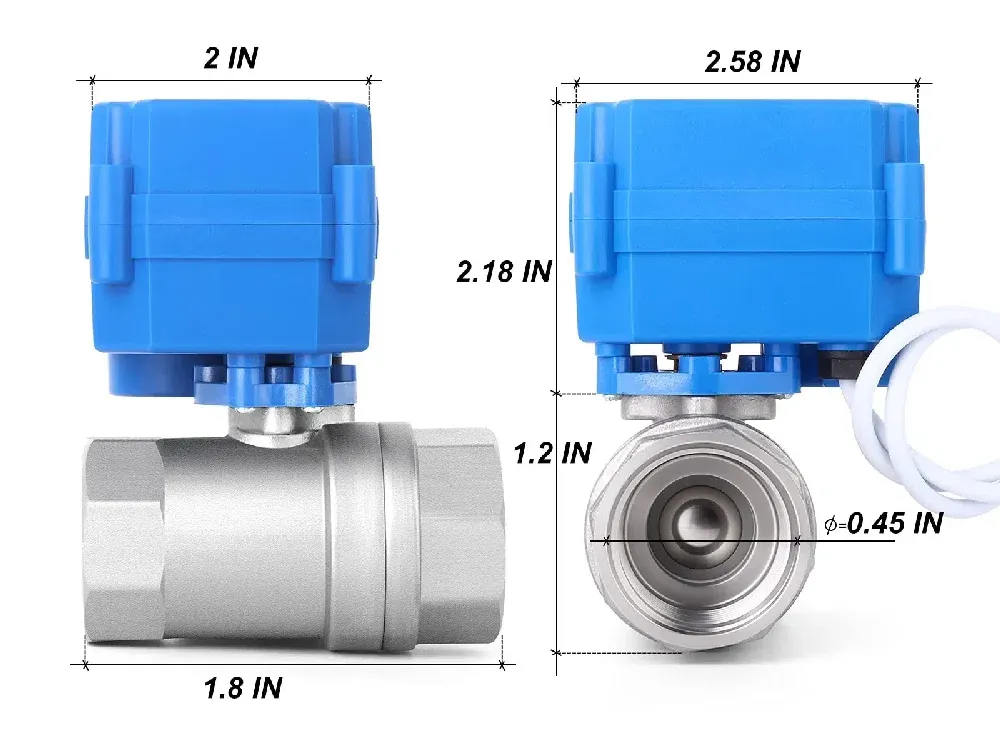Electric ball valves are essential components in industrial and commercial systems that regulate the flow of liquids or gases. These valves combine mechanical efficiency with electrical automation, offering precise control, rapid response times, and reliable performance in demanding environments. Unlike manual valves, electric ball valves can be operated remotely, making them ideal for applications where human intervention is impractical or unsafe.
This article explores the working principles, applications, troubleshooting methods, and maintenance practices for electric ball valves. Additionally, we will examine the critical role of power-failure reset systems in ensuring safety during unexpected outages.
An electric ball valve is an automated flow control device consisting of a spherical plug housed within a metal body. The plug, which has a hollow passage, rotates to open or close the valve, regulating fluid or gas movement. An electric actuator, connected to the valve stem, facilitates this rotation in response to electrical signals.

Fast Operation: Capable of opening or closing within seconds, making them suitable for high-frequency applications.
Precise Flow Control: Can be adjusted to partial openings (e.g., 25%, 50%, 75%) for accurate flow regulation.
Durability: Designed to withstand high pressures and temperatures, ensuring long-term reliability.
Automation Compatibility: Integrates seamlessly with control systems for remote operation.
While electric ball valves excel in quick shut-off and moderate flow control, other valves (such as gate or globe valves) may be better suited for throttling applications requiring fine adjustments.
The electric ball valve operates by converting electrical energy into mechanical motion. When a control signal is sent, the actuator rotates the ball (typically between 0° and 90°), aligning the bore with the pipeline to permit flow or positioning it perpendicular to block flow.
Key Components:
Ball: A spherical plug with a through-hole that allows or restricts flow.
Stem: Connects the ball to the actuator, transmitting rotational force.
Electric Actuator: Drives the valve’s movement using a motor.
Positioner: Ensures accurate valve positioning based on control signals.
Signal Reception: A controller sends an electrical signal to the actuator.
Motor Activation: The actuator’s motor engages, rotating the stem.
Ball Movement: The ball turns to the desired position (open, closed, or partially open).
Flow Regulation: The valve either permits, restricts, or stops fluid/gas flow.
Speed: Electric actuation is significantly faster than manual operation.
Safety: Reduces human exposure to hazardous environments.
Integration: Can be linked to PLCs, SCADA systems, and IoT networks for smart automation.
Electric ball valves are widely used across industries due to their versatility and reliability. Some common applications include:
Chemical Processing: Controls corrosive or high-purity fluid transfer.
Oil & Gas: Manages fuel and gas pipelines with high-pressure resistance.
Water Treatment: Regulates water flow in filtration and distribution systems.
Cooling/Heating Circuits: Modulates refrigerant or hot water flow.
Energy Management: Automates shut-off to conserve energy in unused zones.
Sanitary Fluid Control: Used in hygienic processing with stainless steel construction.
Batch Processing: Ensures precise ingredient dosing.
Steam Control: Manages high-temperature steam lines.
Coolant Systems: Regulates water flow in cooling towers.
Fire Protection: Automatically cuts off gas or water supply during emergencies.
Leak Prevention: Closes valves upon detecting pressure drops or power failures.
Despite their reliability, electric ball valves may encounter operational issues. Below are common problems and solutions:
Cause: Low voltage supply.
Solution: Verify voltage at the valve terminals and check power sources.
Cause: Lack of lubrication or debris accumulation.
Solution: Clean and lubricate the valve stem as per manufacturer guidelines.
Cause: Nearby electromagnetic sources disrupting signals.
Solution: Relocate the valve or install shielding.
Cause: Worn-out seals or damaged components.
Solution: Inspect and replace defective parts.
Proper maintenance extends valve lifespan and prevents unexpected failures.
Check for leaks, corrosion, or unusual noises.
Remove debris from the valve body.
Follow manufacturer guidelines for alignment and torque settings.
Ensure electrical connections are secure.
Install upstream filters to prevent clogging from particulates.
Lubricate moving parts periodically.
Test valve response to control signals.
A critical safety feature in electric ball valves is their ability to automatically close during power outages. This is achieved through two primary mechanisms:
A pre-tensioned spring stores energy during normal operation.
Upon power loss, the spring releases, forcing the valve shut.
Advanced valves use capacitors or batteries to power closure.
Ensures smooth, controlled shut-off for sensitive applications.
Prevents hazardous leaks in chemical or gas systems.
Complies with safety regulations in critical infrastructure.
Electric ball valves are indispensable in modern fluid control systems, offering automation, precision, and safety. Understanding their operation, applications, and maintenance ensures optimal performance and longevity. By implementing preventive measures and leveraging power-failure reset systems, industries can enhance efficiency while mitigating risks.
Whether in water treatment, oil refineries, or HVAC systems, electric ball valves continue to revolutionize flow control with their reliability and adaptability. Investing in high-quality valves and proper upkeep will yield long-term operational benefits.
